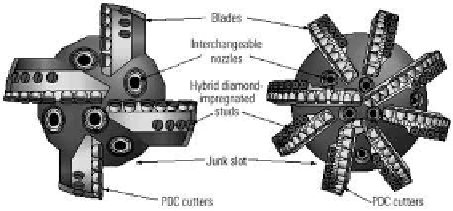Geology Reference
In-Depth Information
For the same reason, it is better to install MWD pressure transducers near
the mudpump pistons rather than faraway, in order to guarantee pressure
doubling. The lead author has in fact demonstrated this counter-intuitive
method in recent field work. At higher data rates, wavelengths decrease;
faraway standpipe pressures do not necessarily see this doubling due to phase
cancellations, and in fact, the presence of the reflected wave may introduce
complications that require multiple transducer processing. This is clearly
avoided by placing the transducer near the piston face, a somewhat counter-
intuitive situation given the “bad reputation” associated with noisy mudpumps.
While mud pump pistons, being solid reflectors, will double an incident
signal, one can prove that low data rate signals in the presence of centrifugal
mud pumps will go almost undetected because the boundary condition u
x
= 0
holds. This signal loss has often confused drilling engineers running MWD
tools that are in apparently perfect mechanical condition. At higher data rates,
the cancellation between left and right-going waves is less perfect and some
signal may be detectable and recoverable using multiple transducer methods.
Often, confusing issues are easily explained using simple acoustic arguments.
9.5.3 Drillbit nozzles.
The effects of solid and open reflectors on surface signals have been
emphasized. Similar considerations apply downhole at the bit. Figure 9.21
shows two bits, one with greater nozzle area than the other. In either case, we
caution against “solid versus open” based on appearances alone. While areas
are important from a mud transport perspective, they enter only indirectly in the
case of wave reflections. As shown in Chapter 2, the pertinent parameters are
relative axial and cross dimensions, wavelengths and sound speeds - whether a
drillbit is solid or open as a reflector should be ascertained using the rigorous
six-segment waveguide model previously developed. In the mid-1990s, the lead
author obtained his constructive interference patent assuming the bit as a solid
reflector, not knowing at the time that this “obvious” conclusion was rarely
correct. Again, Chapter 2 explains the subtleties in detail.
Figure 9.21.
Drillbits with different nozzle sizes.

Search WWH ::

Custom Search